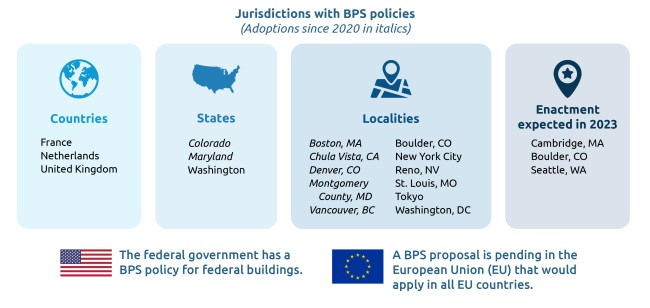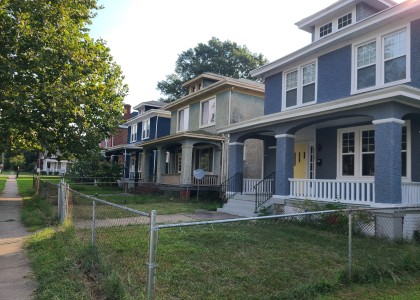Residential and commercial building energy use is responsible for 30% of carbon emissions in the United States. In 2050, the majority of building energy use will be in buildings that are standing today. To address emissions from these buildings, one growing climate policy in jurisdictions across the nation and beyond is enacting performance standards that require buildings to reduce energy use or emissions over time. A new report from the American Council for an Energy-Efficient Economy (ACEEE) examines the building performance standards (BPS) in 18 jurisdictions—including 3 countries, 3 states, 11 cities, and for federal government buildings. BPS policies are pending in 4 jurisdictions, bringing the total to 22, more than double the 10 policies in place in 2020. Current and pending standards, including the 8 standards adopted since 2020, are shown in the table below.
Building performance standards are being successfully implemented in Boulder, Colorado; Tokyo; the United Kingdom; and the Netherlands. Other jurisdictions with BPS policies are now developing regulations and working with building owners to prepare for the mandatory standards to take effect. Compliance dates of domestic building performance standards range from 2024 to the early 2030s, varying by jurisdiction and building size (in many jurisdictions, standards initially apply to larger commercial buildings and apply to smaller buildings later). In most jurisdictions, standards get progressively more stringent over time, with new standards typically taking effect every five years. Most standards cover commercial and multifamily residential buildings above a size threshold, which ranges from 10,000 to 100,000 square feet of floor area.
When we last examined BPS progress, in 2020, most of the standards specified levels of energy performance, such as maximum Btu (British thermal units) of energy consumption per square foot of building floor area. Performance standards are commonly based on median energy use in each building type, with buildings below the median needing to upgrade. But recently, a growing number of jurisdictions are setting standards based on carbon emissions, not energy. Carbon emissions standards are generally more complicated but can gradually ramp down to zero emissions, helping jurisdictions meet their long-term climate goals. However, carbon standards alone do not directly promote energy efficiency, potentially leading to strained power grids, less comfortable buildings, and larger and more expensive building equipment. For this reason, some jurisdictions are setting complementary energy and carbon standards to encourage both energy efficiency and decarbonization.
In addition to describing the standards in each of the 22 enacted and pending jurisdictions, the new ACEEE report draws on experience to date to address a set of issues, such as developing building performance standards; setting BPS coverage, metrics, and targets; addressing equity issues; implementing the standards; options for compliance; and financing for the required building upgrades.
Since implementation is just beginning, it is too early to draw many conclusions. However, we find that stakeholder consultation is important both before standards are proposed and as implementation proceeds. Building energy benchmarking is generally an important precursor for performance standards, although a few jurisdictions have used detailed building modeling and other data in lieu of benchmarking information. Multiple approaches to performance standards are available, and each jurisdiction should pursue options that work for its buildings and communities, so it will take time to build support and work out details.
For standards to be successful, jurisdictions must prioritize implementation, adequate staffing, and complementing standards with other policies and programs. Complementary activities can include providing building owners with easily accessible information on building performance and BPS requirements, education and technical assistance on ways to reach required performance levels, and monetary incentives and financing to help cover costs.
Special attention also must be paid to how performance standards apply in critical markets such as affordable housing. Many jurisdictions are establishing and funding programs to help affordable housing meet the standards while keeping rents affordable. As BPS policies are implemented, evaluation will be important to improve the policies and inform future discussions on the best approaches.
Building performance standards, implemented alongside complementary measures, can be an important contributor to efforts to meet energy and climate targets. As more jurisdictions enact BPS policies, their peers can learn valuable lessons on the most effective ways to structure and implement policies that improve the quality of housing and workplaces while achieving large energy savings and reductions in climate pollution.




